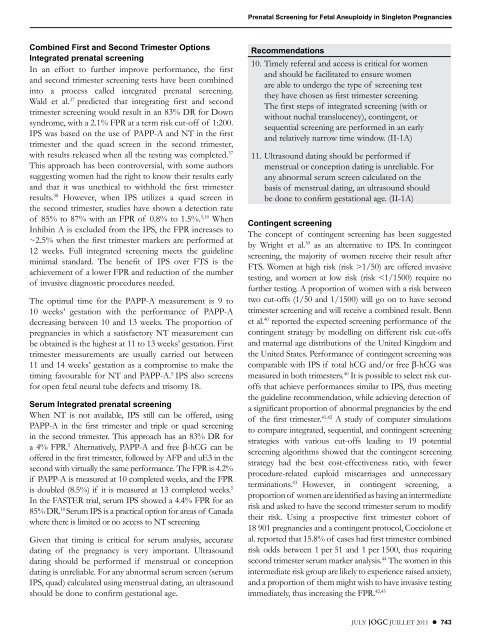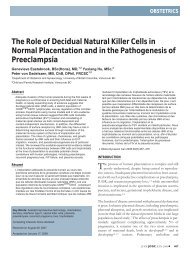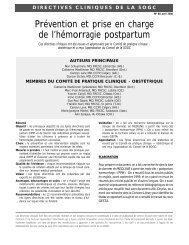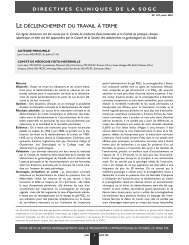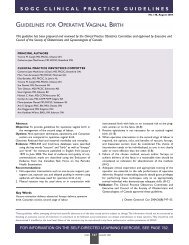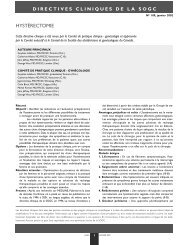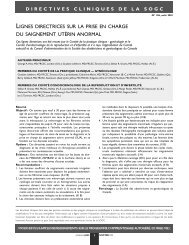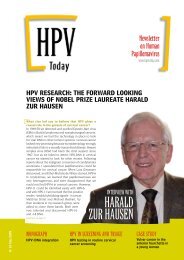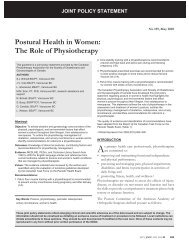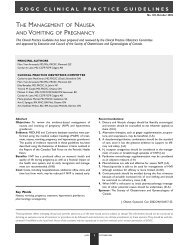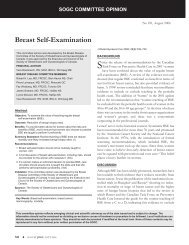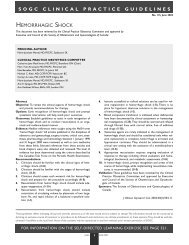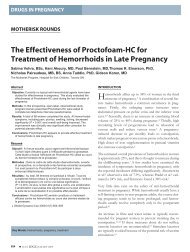Prenatal Screening for Fetal Aneuploidy in Singleton ... - SOGC
Prenatal Screening for Fetal Aneuploidy in Singleton ... - SOGC
Prenatal Screening for Fetal Aneuploidy in Singleton ... - SOGC
Create successful ePaper yourself
Turn your PDF publications into a flip-book with our unique Google optimized e-Paper software.
Comb<strong>in</strong>ed First and Second Trimester Options<br />
Integrated prenatal screen<strong>in</strong>g<br />
In an ef<strong>for</strong>t to further improve per<strong>for</strong>mance, the first<br />
and second trimester screen<strong>in</strong>g tests have been comb<strong>in</strong>ed<br />
<strong>in</strong>to a process called <strong>in</strong>tegrated prenatal screen<strong>in</strong>g.<br />
Wald et al. 37 predicted that <strong>in</strong>tegrat<strong>in</strong>g first and second<br />
trimester screen<strong>in</strong>g would result <strong>in</strong> an 83% DR <strong>for</strong> Down<br />
syndrome, with a 2.1% FPR at a term risk cut-off of 1:200.<br />
IPS was based on the use of PAPP-A and NT <strong>in</strong> the first<br />
trimester and the quad screen <strong>in</strong> the second trimester,<br />
with results released when all the test<strong>in</strong>g was completed. 37<br />
This approach has been controversial, with some authors<br />
suggest<strong>in</strong>g women had the right to know their results early<br />
and that it was unethical to withhold the first trimester<br />
results. 38 However, when IPS utilizes a quad screen <strong>in</strong><br />
the second trimester, studies have shown a detection rate<br />
of 85% to 87% with an FPR of 0.8% to 1.5%. 5,10 When<br />
Inhib<strong>in</strong> A is excluded from the IPS, the FPR <strong>in</strong>creases to<br />
~2.5% when the first trimester markers are per<strong>for</strong>med at<br />
12 weeks. Full <strong>in</strong>tegrated screen<strong>in</strong>g meets the guidel<strong>in</strong>e<br />
m<strong>in</strong>imal standard. The benefit of IPS over FTS is the<br />
achievement of a lower FPR and reduction of the number<br />
of <strong>in</strong>vasive diagnostic procedures needed.<br />
The optimal time <strong>for</strong> the PAPP-A measurement is 9 to<br />
10 weeks’ gestation with the per<strong>for</strong>mance of PAPP-A<br />
decreas<strong>in</strong>g between 10 and 13 weeks. The proportion of<br />
pregnancies <strong>in</strong> which a satisfactory NT measurement can<br />
be obta<strong>in</strong>ed is the highest at 11 to 13 weeks’ gestation. First<br />
trimester measurements are usually carried out between<br />
11 and 14 weeks’ gestation as a compromise to make the<br />
tim<strong>in</strong>g favourable <strong>for</strong> NT and PAPP-A. 5 IPS also screens<br />
<strong>for</strong> open fetal neural tube defects and trisomy 18.<br />
Serum Integrated prenatal screen<strong>in</strong>g<br />
When NT is not available, IPS still can be offered, us<strong>in</strong>g<br />
PAPP-A <strong>in</strong> the first trimester and triple or quad screen<strong>in</strong>g<br />
<strong>in</strong> the second trimester. This approach has an 83% DR <strong>for</strong><br />
a 4% FPR. 5 Alternatively, PAPP-A and free β-hCG can be<br />
offered <strong>in</strong> the first trimester, followed by AFP and uE3 <strong>in</strong> the<br />
second with virtually the same per<strong>for</strong>mance. The FPR is 4.2%<br />
if PAPP-A is measured at 10 completed weeks, and the FPR<br />
is doubled (8.5%) if it is measured at 13 completed weeks. 5<br />
In the FASTER trial, serum IPS showed a 4.4% FPR <strong>for</strong> an<br />
85% DR. 10 Serum IPS is a practical option <strong>for</strong> areas of Canada<br />
where there is limited or no access to NT screen<strong>in</strong>g.<br />
Given that tim<strong>in</strong>g is critical <strong>for</strong> serum analysis, accurate<br />
dat<strong>in</strong>g of the pregnancy is very important. Ultrasound<br />
dat<strong>in</strong>g should be per<strong>for</strong>med if menstrual or conception<br />
dat<strong>in</strong>g is unreliable. For any abnormal serum screen (serum<br />
IPS, quad) calculated us<strong>in</strong>g menstrual dat<strong>in</strong>g, an ultrasound<br />
should be done to confirm gestational age.<br />
<strong>Prenatal</strong> <strong>Screen<strong>in</strong>g</strong> <strong>for</strong> <strong>Fetal</strong> <strong>Aneuploidy</strong> <strong>in</strong> S<strong>in</strong>gleton Pregnancies<br />
Recommendations<br />
10. Timely referral and access is critical <strong>for</strong> women<br />
and should be facilitated to ensure women<br />
are able to undergo the type of screen<strong>in</strong>g test<br />
they have chosen as first trimester screen<strong>in</strong>g.<br />
The first steps of <strong>in</strong>tegrated screen<strong>in</strong>g (with or<br />
without nuchal translucency), cont<strong>in</strong>gent, or<br />
sequential screen<strong>in</strong>g are per<strong>for</strong>med <strong>in</strong> an early<br />
and relatively narrow time w<strong>in</strong>dow. (II-1A)<br />
11. Ultrasound dat<strong>in</strong>g should be per<strong>for</strong>med if<br />
menstrual or conception dat<strong>in</strong>g is unreliable. For<br />
any abnormal serum screen calculated on the<br />
basis of menstrual dat<strong>in</strong>g, an ultrasound should<br />
be done to confirm gestational age. (II-1A)<br />
Cont<strong>in</strong>gent screen<strong>in</strong>g<br />
The concept of cont<strong>in</strong>gent screen<strong>in</strong>g has been suggested<br />
by Wright et al. 39 as an alternative to IPS. In cont<strong>in</strong>gent<br />
screen<strong>in</strong>g, the majority of women receive their result after<br />
FTS. Women at high risk (risk >1/50) are offered <strong>in</strong>vasive<br />
test<strong>in</strong>g, and women at low risk (risk


